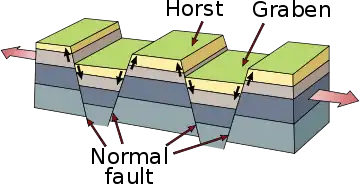Horst and graben
In geology, horst and graben (or range and valley) refers to topography consisting of alternating raised and lowered fault blocks known as horsts and grabens. The features are created by normal faulting and rifting caused by crustal extension.[1] Horst and graben are formed when normal faults of opposite dip occur in pairs with parallel strike, and are always formed together. Each feature can range in size from a few centimeters up to tens of kilometers, and the vertical displacement can be up to several thousand meters. The movement on either side of each block is typically equal, resulting in little tilting.[2]

Features
Horst
A horst is a section of crust that has been lifted relative to the blocks on either side, which is a result of its bounding faults dipping away from each other.[2] Horsts can form features such as plateaus, mountain ranges or ridges on either side of the valleys.[1]
Graben
A graben is a section of crust that has lowered relative to the blocks on either side, which is a result of its bounding faults dipping towards each other.[2] The plural of graben can be either graben or grabens. Graben form low-lying features such as basins and rift valleys.[1][2] They can be very long relative to their width.
Examples
- The Basin and Range Province in the western United States is an extensive region of alternating valleys and ridges caused by horst and graben as well as tilted block faulting.[1]
- The Satpura Range is a horst in India and is flanked by Narmada Graben in the north and much smaller but parallel Tapi Graben in the south.[3][4]
References
- "Horst and Graben". National Park Service. 2020-04-22.
- "horst and graben". Encyclopædia Britannica.
- Valdiya, K. S. (2015-11-26). The Making of India: Geodynamic Evolution. Springer. ISBN 9783319250298.
- Valdiya, K.S.; Sanwal, Jaishri (2017-01-01). "Satpura Horst and Narmada–Tapi Grabens". Neotectonism in the Indian Subcontinent - Landscape Evolution. Developments in Earth Surface Processes. Vol. 22. pp. 237–247. doi:10.1016/B978-0-444-63971-4.00010-4. ISBN 9780444639714. ISSN 0928-2025.